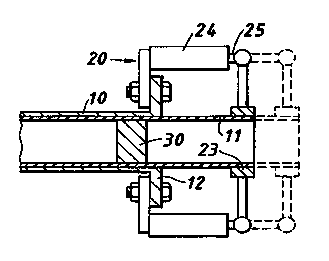Some of the information on this Web page has been provided by external sources. The Government of Canada is not responsible for the accuracy, reliability or currency of the information supplied by external sources. Users wishing to rely upon this information should consult directly with the source of the information. Content provided by external sources is not subject to official languages, privacy and accessibility requirements.
Any discrepancies in the text and image of the Claims and Abstract are due to differing posting times. Text of the Claims and Abstract are posted:
| (12) Patent Application: | (11) CA 2334275 |
|---|---|
| (54) English Title: | PIPE LINING |
| (54) French Title: | REVETEMENT INTERIEUR DE CONDUITES |
| Status: | Deemed Abandoned and Beyond the Period of Reinstatement - Pending Response to Notice of Disregarded Communication |
| (51) International Patent Classification (IPC): |
|
|---|---|
| (72) Inventors : |
|
| (73) Owners : |
|
| (71) Applicants : |
|
| (74) Agent: | GOWLING WLG (CANADA) LLPGOWLING WLG (CANADA) LLP |
| (74) Associate agent: | |
| (45) Issued: | |
| (86) PCT Filing Date: | 1998-06-10 |
| (87) Open to Public Inspection: | 1999-12-16 |
| Examination requested: | 2000-11-29 |
| Availability of licence: | N/A |
| Dedicated to the Public: | N/A |
| (25) Language of filing: | English |
| Patent Cooperation Treaty (PCT): | Yes |
|---|---|
| (86) PCT Filing Number: | PCT/GB1998/001552 |
| (87) International Publication Number: | WO 1999064222 |
| (85) National Entry: | 2000-11-29 |
| (30) Application Priority Data: | None |
|---|
A lining method for a host pipe (10) including lubrication of the host pipe
prior to insertion of a thermoplastic liner (11) using tight fit techniques.
After allowing the inserted liner to relax, the liner is partially pulled from
within the host pipe using puller (20) and clamped with an internal clamp (30)
to allow fitting of a special flange (40) to the liner (11) by butt fusion,
for example. Thereafter the liner is allowed to revert so as to abut a flange
(12) fitted to the host pipe (10). The technique is repeated at the other pipe
end.
Procédé de revêtement intérieur pour conduite réceptrice (10), qui consiste à lubrifier ladite conduite avant d'introduire un revêtement intérieur thermoplastique (11) à l'aide de techniques d'ajustement serré. Une fois le revêtement intérieur relâché, ce dernier est partiellement tiré depuis l'intérieur de la conduite à l'aide d'un dispositif de traction (20) et serré à l'aide d'un élément de serrage interne (30) pour permettre l'adaptation d'une bride spéciale (40) sur le revêtement (11) par fusion bout à bout, par exemple. Ensuite, on laisse le revêtement rentrer dans la conduite de manière à ce qu'il vienne en contact avec une bride (12) installée sur la conduite réceptrice (10). Ladite technique est répétée à l'autre extrémité de la conduite.
Note: Claims are shown in the official language in which they were submitted.
Note: Descriptions are shown in the official language in which they were submitted.

2024-08-01:As part of the Next Generation Patents (NGP) transition, the Canadian Patents Database (CPD) now contains a more detailed Event History, which replicates the Event Log of our new back-office solution.
Please note that "Inactive:" events refers to events no longer in use in our new back-office solution.
For a clearer understanding of the status of the application/patent presented on this page, the site Disclaimer , as well as the definitions for Patent , Event History , Maintenance Fee and Payment History should be consulted.
| Description | Date |
|---|---|
| Inactive: IPC from MCD | 2006-03-12 |
| Inactive: IPC from MCD | 2006-03-12 |
| Application Not Reinstated by Deadline | 2004-06-10 |
| Time Limit for Reversal Expired | 2004-06-10 |
| Deemed Abandoned - Failure to Respond to Maintenance Fee Notice | 2003-06-10 |
| Letter Sent | 2002-07-02 |
| Letter Sent | 2002-02-14 |
| Letter Sent | 2002-02-14 |
| Letter Sent | 2002-02-14 |
| Inactive: Single transfer | 2002-01-11 |
| Inactive: Courtesy letter - Evidence | 2001-05-08 |
| Inactive: Single transfer | 2001-03-29 |
| Inactive: Cover page published | 2001-03-26 |
| Inactive: First IPC assigned | 2001-03-20 |
| Inactive: Courtesy letter - Evidence | 2001-03-13 |
| Inactive: Acknowledgment of national entry - RFE | 2001-03-09 |
| Application Received - PCT | 2001-03-07 |
| All Requirements for Examination Determined Compliant | 2000-11-29 |
| Request for Examination Requirements Determined Compliant | 2000-11-29 |
| Application Published (Open to Public Inspection) | 1999-12-16 |
| Abandonment Date | Reason | Reinstatement Date |
|---|---|---|
| 2003-06-10 |
The last payment was received on 2002-05-27
Note : If the full payment has not been received on or before the date indicated, a further fee may be required which may be one of the following
Please refer to the CIPO Patent Fees web page to see all current fee amounts.
| Fee Type | Anniversary Year | Due Date | Paid Date |
|---|---|---|---|
| Basic national fee - standard | 2000-11-29 | ||
| Registration of a document | 2000-11-29 | ||
| MF (application, 2nd anniv.) - standard | 02 | 2000-06-12 | 2000-11-29 |
| Request for examination - standard | 2000-11-29 | ||
| Registration of a document | 2001-03-29 | ||
| MF (application, 3rd anniv.) - standard | 03 | 2001-06-11 | 2001-05-25 |
| Registration of a document | 2002-01-11 | ||
| MF (application, 4th anniv.) - standard | 04 | 2002-06-10 | 2002-05-27 |
Note: Records showing the ownership history in alphabetical order.
| Current Owners on Record |
|---|
| BG TRANSCO PLC |
| LATTICE INTELLECTUAL PROPERTY LTD. |
| Past Owners on Record |
|---|
| BRIAN EDWARD MCGUIRE |